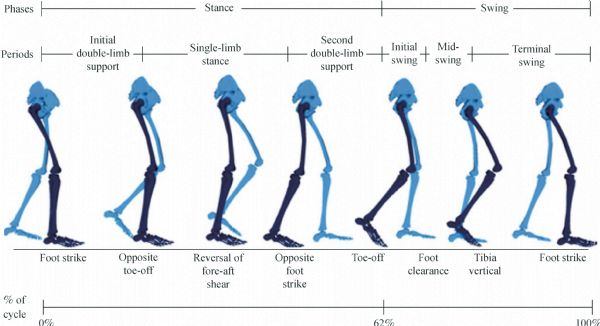

Frontiers of Mechanical Engineering >
Modeling and simulation of normal and hemiparetic gait
Received date: 02 Feb 2015
Accepted date: 25 Jun 2015
Published date: 23 Sep 2015
Copyright
Gait is the collective term for the two types of bipedal locomotion, walking and running. This paper is focused on walking. The analysis of human gait is of interest to many different disciplines, including biomechanics, human-movement science, rehabilitation and medicine in general. Here we present a new model that is capable of reproducing the properties of walking, normal and pathological. The aim of this paper is to establish the biomechanical principles that underlie human walking by using Lagrange method. The constraint forces of Rayleigh dissipation function, through which to consider the effect on the tissues in the gait, are included. Depending on the value of the factor present in the Rayleigh dissipation function, both normal and pathological gait can be simulated. First of all, we apply it in the normal gait and then in the permanent hemiparetic gait. Anthropometric data of adult person are used by simulation, and it is possible to use anthropometric data for children but is necessary to consider existing table of anthropometric data. Validation of these models includes simulations of passive dynamic gait that walk on level ground. The dynamic walking approach provides a new perspective of gait analysis, focusing on the kinematics and kinetics of gait. There have been studies and simulations to show normal human gait, but few of them have focused on abnormal, especially hemiparetic gait. Quantitative comparisons of the model predictions with gait measurements show that the model can reproduce the significant characteristics of normal gait.

Key words: bipedal gait; biomechanics; dynamic walking; gait model; human gait; hemiparetic human gait
Lely A. LUENGAS , Esperanza CAMARGO , Giovanni SANCHEZ . Modeling and simulation of normal and hemiparetic gait[J]. Frontiers of Mechanical Engineering, 2015 , 10(3) : 233 -241 . DOI: 10.1007/s11465-015-0343-0
| 1 |
Collado S. Analysis of human walking with load platforms. Influence of freight. Dissertation for the Doctoral Degree. Madrid: Universidad Complutense de Madrid, 2002
|
| 2 |
Routson R L, Kautz S A, Neptune R R. Modular organization across changing task demands in healthy and poststroke gait. Physiological Reports, 2014, 2(6): e12055
|
| 3 |
Lim M R, Huang R C, Wu A,
|
| 4 |
Gage J, Deluca P, Renshaw T. Gait analysis: Principles and applications. Journal of Bone and Joint Surgery—American Volume, 1995, 77: 1607–1623
|
| 5 |
Kuo A D. The six determinants of gait and the inverted pendulum analogy: A dynamic walking perspective. Human Movement Science, 2007, 26(4): 617–656
|
| 6 |
Whittle M. Gait Analysis: An Introduction. 4th ed. Elsevier, 2007
|
| 7 |
Luengas L, Camargo E, Sanchez G. Patellar tendon behavior during the sub-phase loading response. In: Proceedings of 2011 International Symposium on IT in Medicine and Education (ITME). Guangzhou: IEEE, 2011, 1, 694–698
|
| 8 |
McGeer T. Dynamics and control of bipedal locomotion. Journal of Theoretical Biology, 1993, 163(3): 277–314
|
| 9 |
Chai H. The gait during ambulation
|
| 10 |
Dupilka A. Pediatric patient resources.
|
| 11 |
Mulroy S, Gronley J, Weiss W,
|
| 12 |
Hsu A L, Tang P F, Jan M H. Analysis of impairments influencing gait velocity and asymmetry of hemiplegic patients after mild to moderate stroke. Archives of Physical Medicine and Rehabilitation, 2003, 84(8): 1185–1193
|
| 13 |
Jonkers I, Stewart C, Spaepen A. The study of muscle action during single support and swing phase of gait: clinical relevance of forward simulation techniques. Gait & Posture, 2003, 17(2): 97–105
|
| 14 |
Giuliani C A. Adult hemiplegic gait. In: Smitd G L, ed. Gait in Rehabilitation: Clinics Physical Therapy. New York: Churchill Livingstone, 1990, 253–266
|
| 15 |
Pai Y C, Rogers M W, Hedman L D,
|
| 16 |
Palencia R. Trastornos de la marcha. Protocolo diagnóstico. Boletín Pediatrico, 2000, 40: 97–99 (in Spanish)
|
| 17 |
Beséler M. Estudio de los parámetros cináticos de la marcha del paciente hemipléjico mediante plataformas dinamométricas.
|
| 18 |
Perry J. Gait Analysis: Normal and Pathological Function. Thorofare: Slack, Inc., 1992
|
| 19 |
Tesio L, Civaschi P, Tessari L. Motion of the center of gravity of the body in clinical evaluation of gait. American Journal of Physical Medicine, 1985, 64(2): 57–70
|
| 20 |
Olney S J, Colborne G R, Martin C S. Joint angle feedback and biomechanical gait analysis in stroke patients: A case report. Physical Therapy, 1989, 69(10): 863–870
|
| 21 |
Olney S J, Griffin M P, McBride I D. Temporal, kinematic, and kinetic variables related to gait speed in subjects with hemiplegia: a regression approach. Physical Therapy, 1994, 74(9): 872–885
|
| 22 |
Winter D A. Energy generation and absorption at the ankle and knee during fast, natural, and slow cadences. Clinical Orthopaedics and Related Research, 1983, (175): 147–154
|
| 23 |
Knutsson E. Can gait analysis improve gait training in stroke patients. Scandinavian Journal of Rehabilitation Medicine, 1994, 30(Suppl): 73–80
|
| 24 |
Peterson D, Bronzino J. Biomechanics Principles and Applications. Boca Raton: CRC Press, 2008
|
| 25 |
Tang Z, Meng Joo Er, Chien C J. Analysis of human gait using an inverted pendulum model. In: Proceedings of IEEE International Conference on Fuzzy Systems. Hong Kong: IEEE, 2008
|
| 26 |
Kuo A D, Donelan J M. Dynamic principles of gait and their clinical implications. Physical Therapy, 2010, 90(2): 157–174
|
| 27 |
Oberg T, Karsznia A, Oberg K. Basic gait parameters: reference data for normal subjects, 10−79 years of age. Journal of Rehabilitation Research and Development, 1993, 30(2): 210–223
|
| 28 |
Onyshko S, Winter D A. A mathematical model for the dynamics of human locomotion. Journal of Biomechanics, 1980, 13(4): 361–368
|
/
| 〈 |
|
〉 |